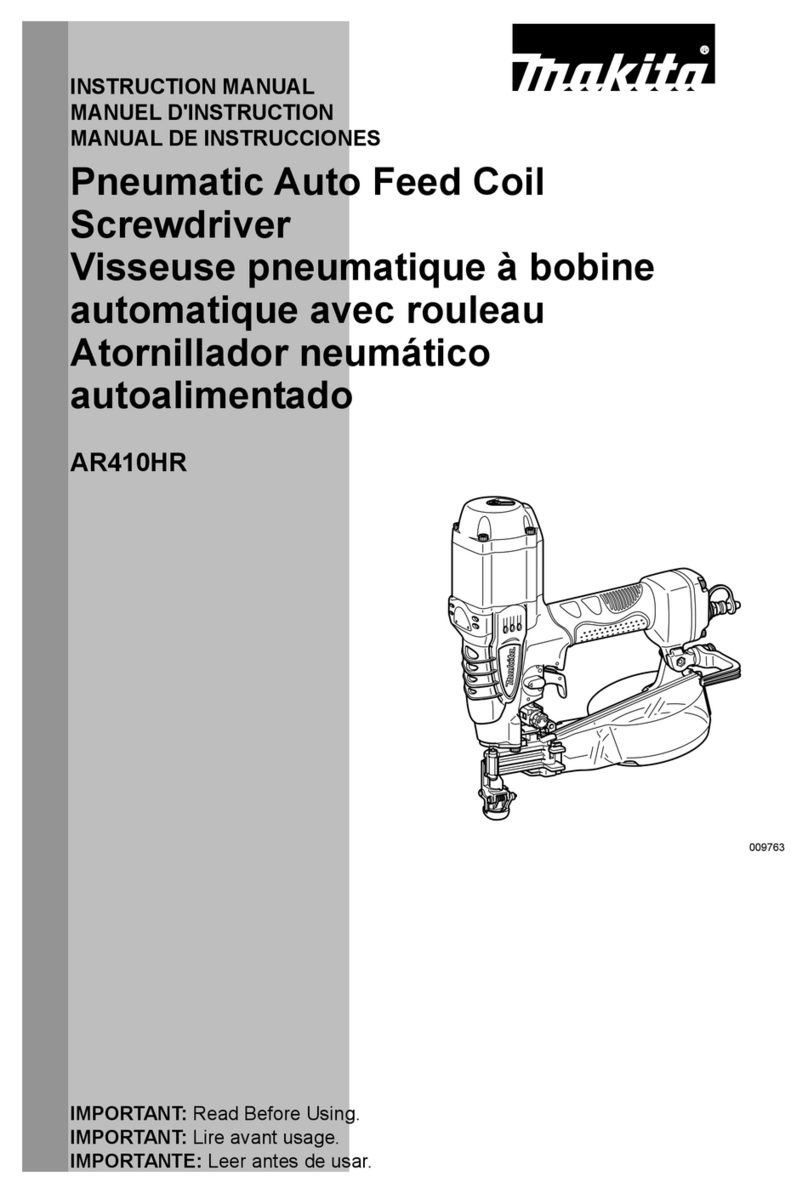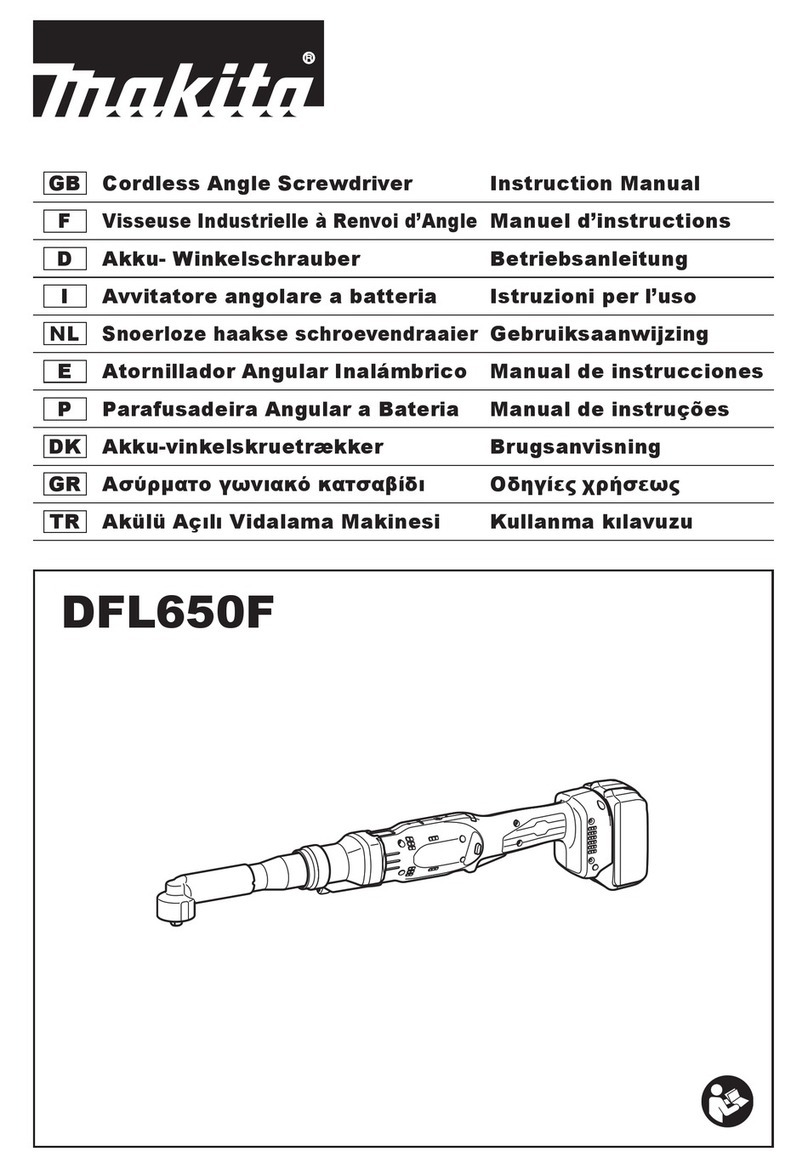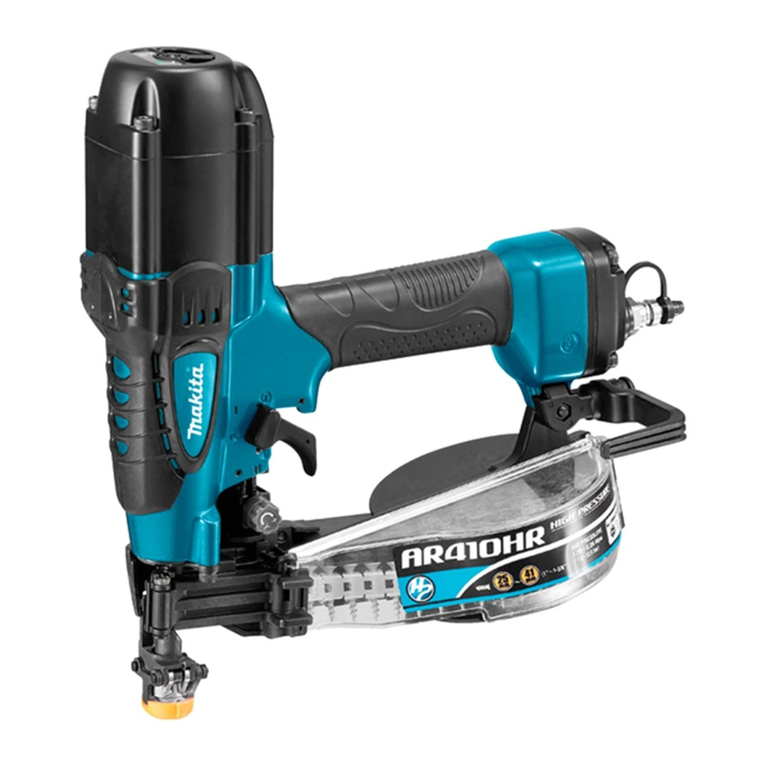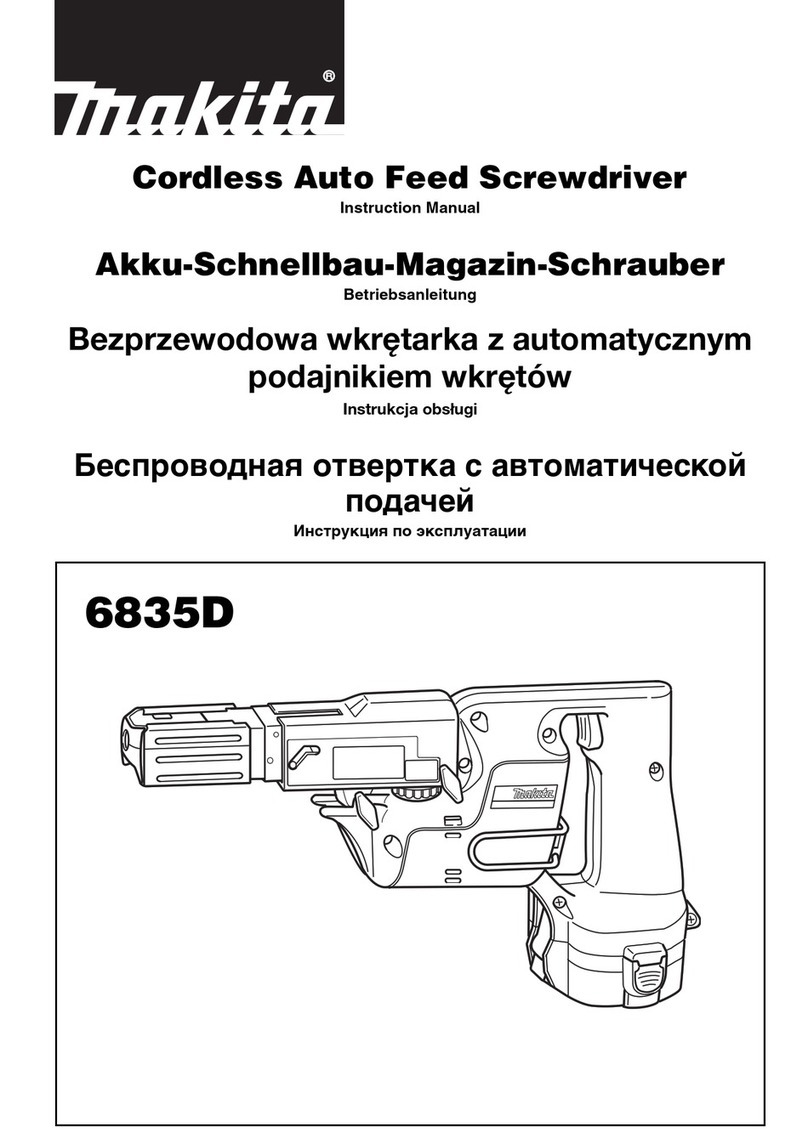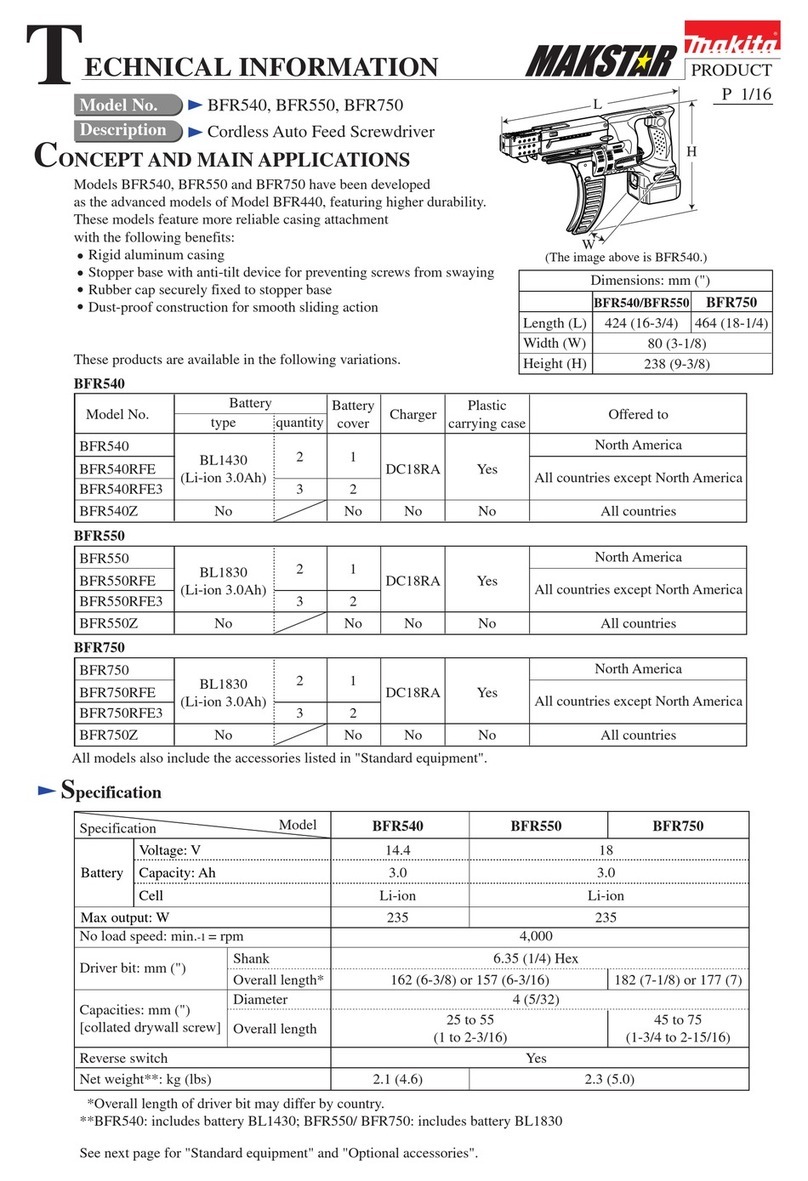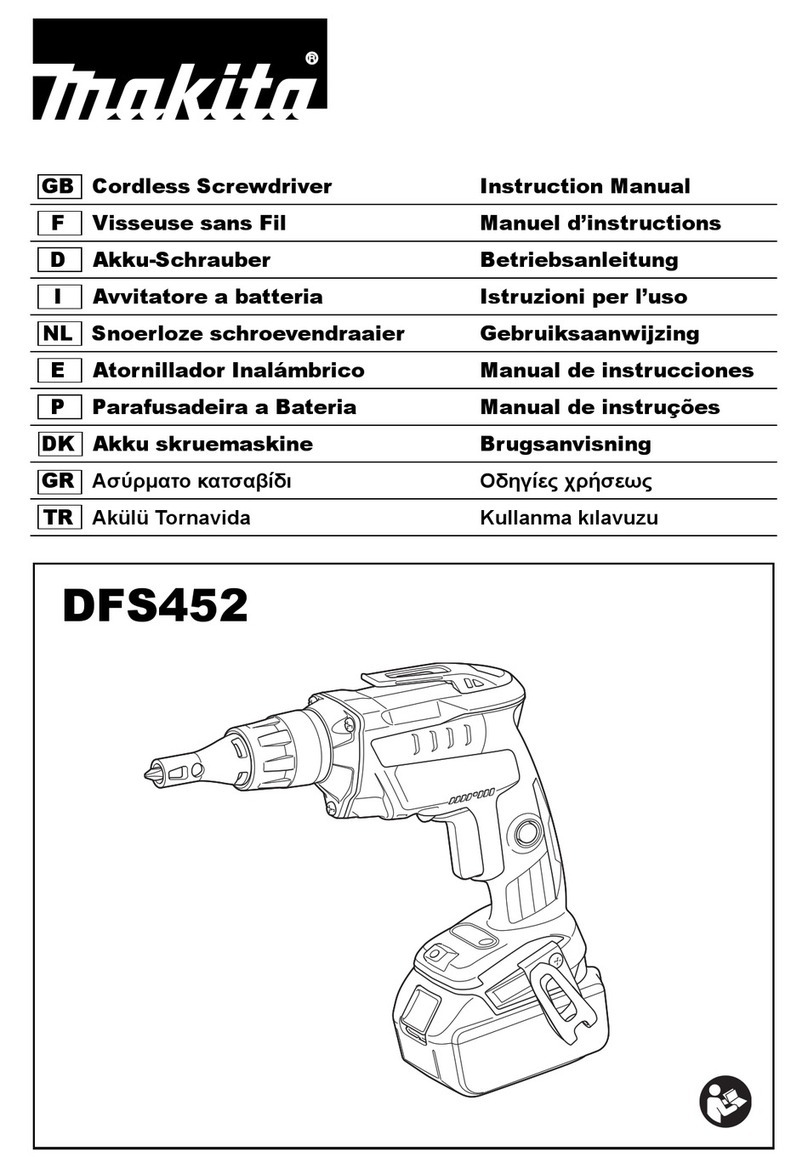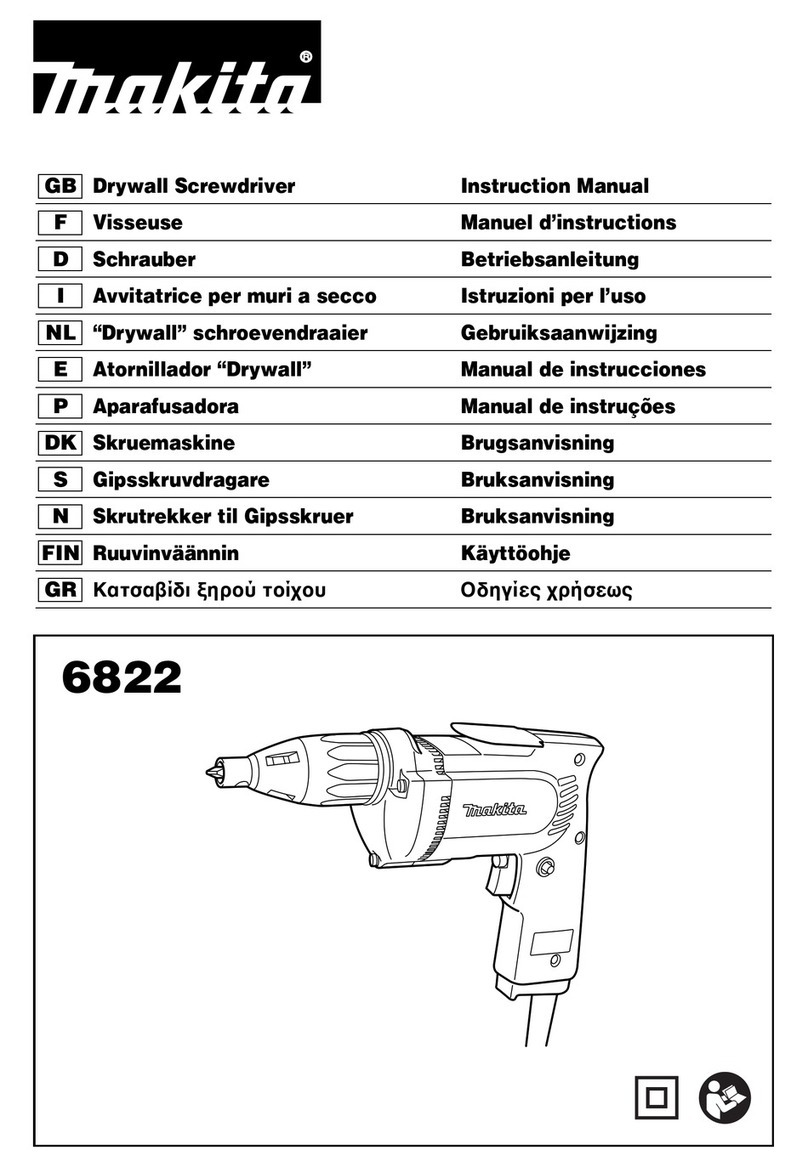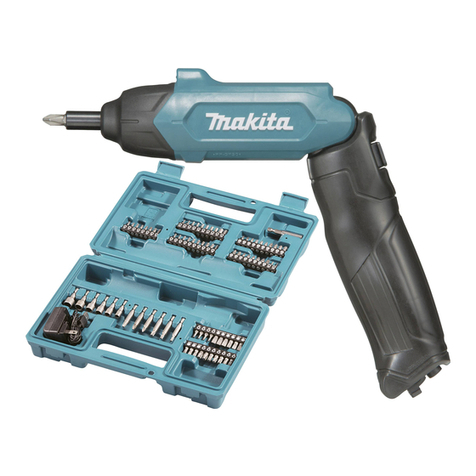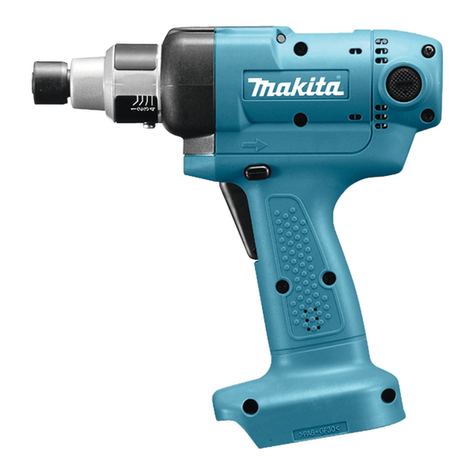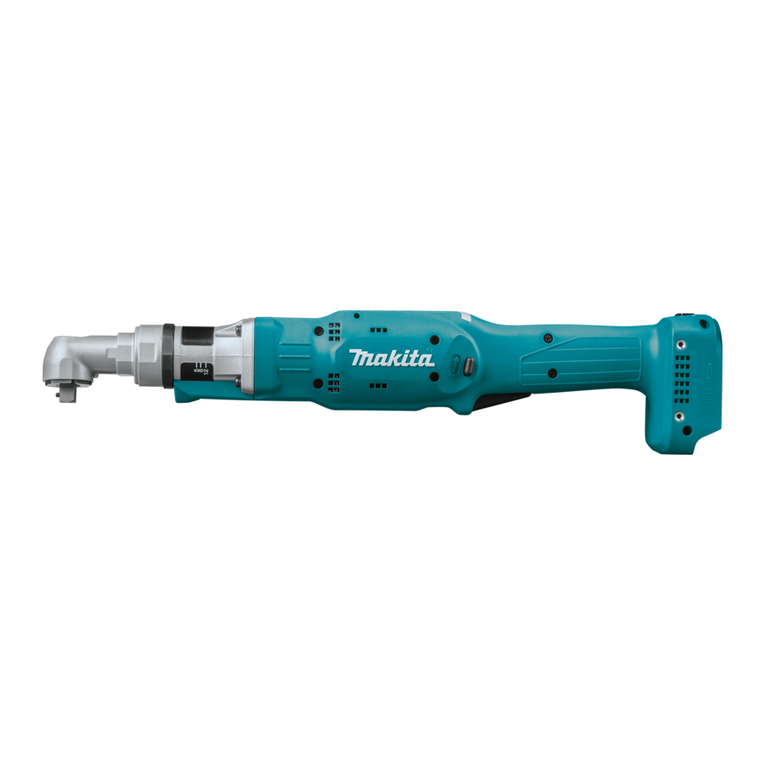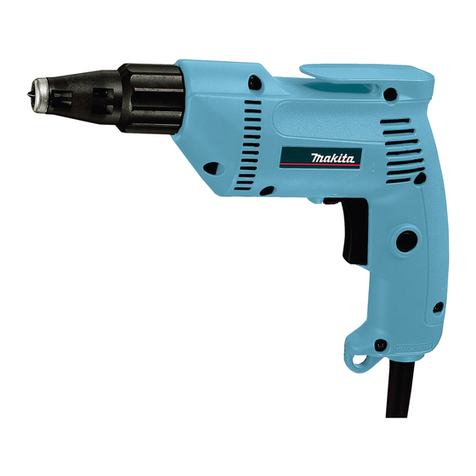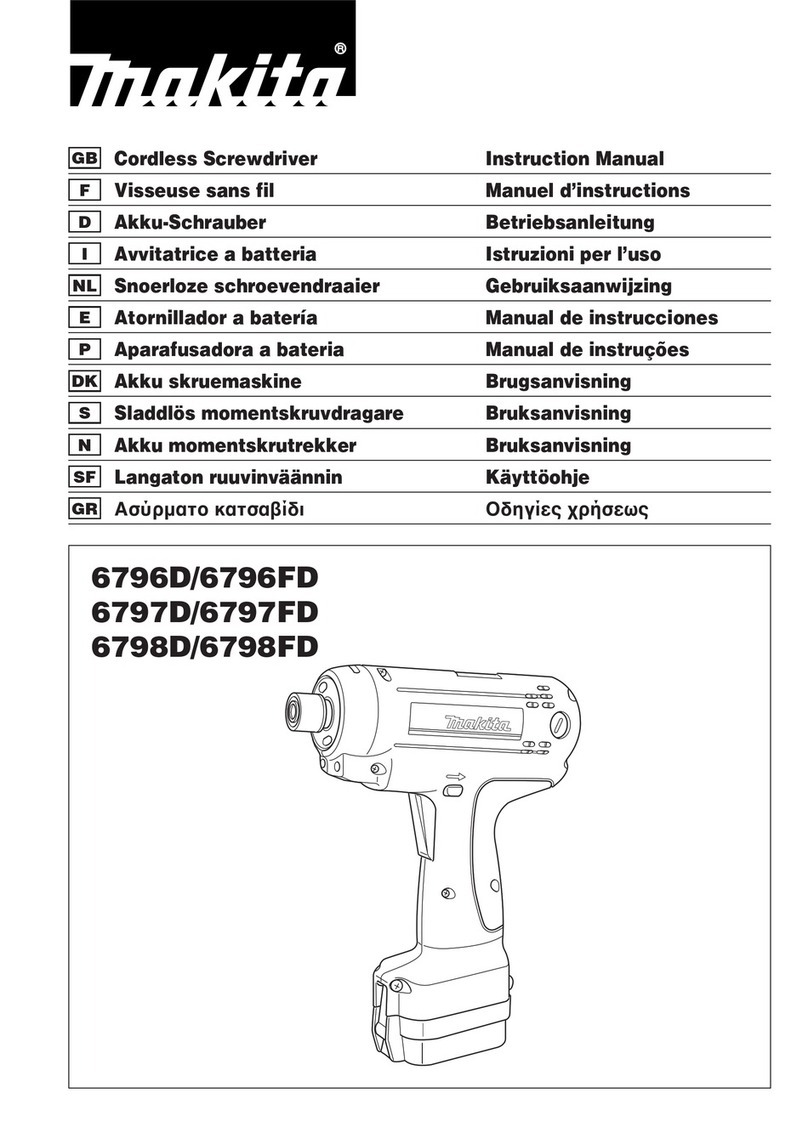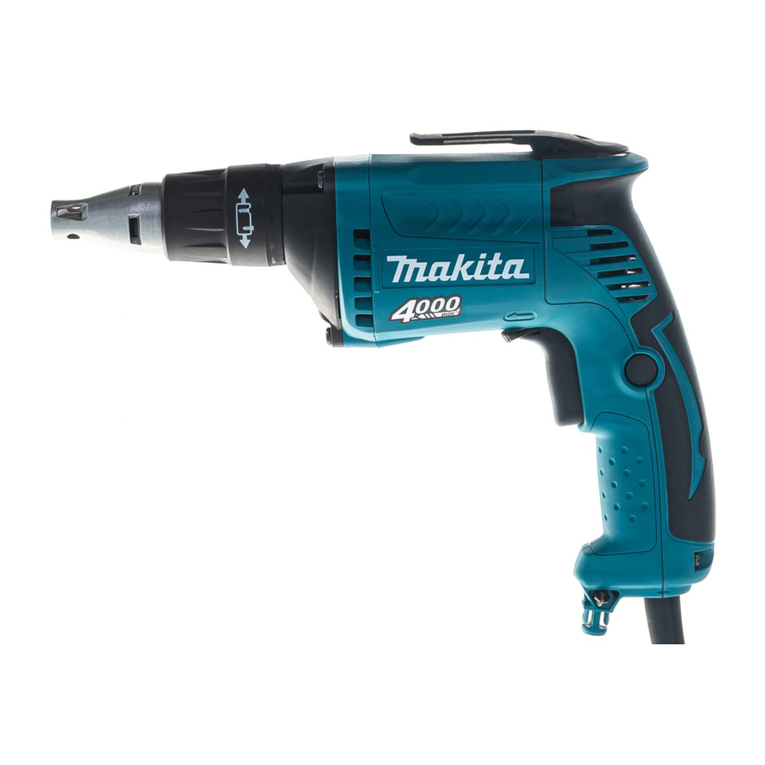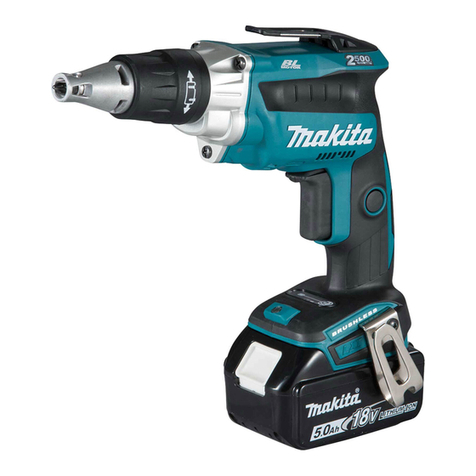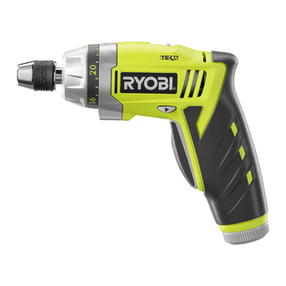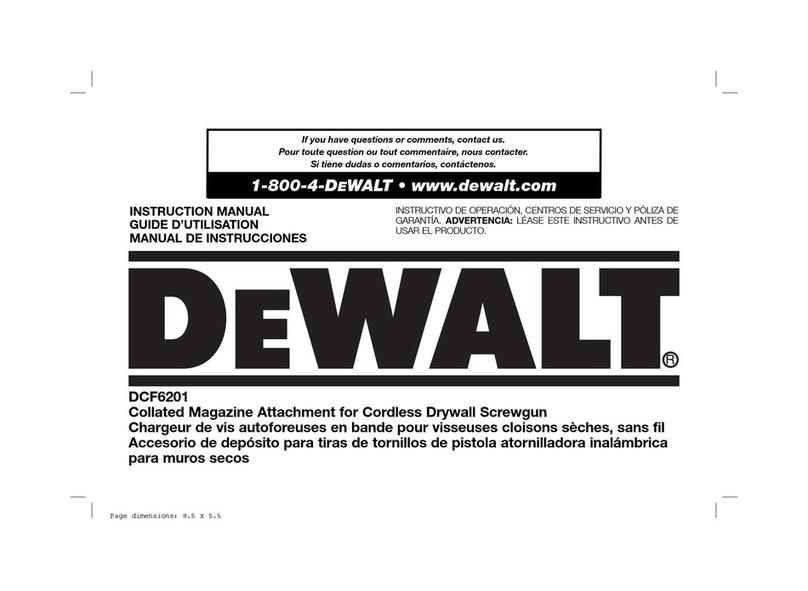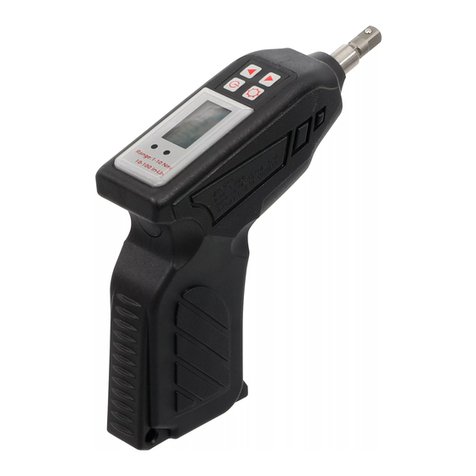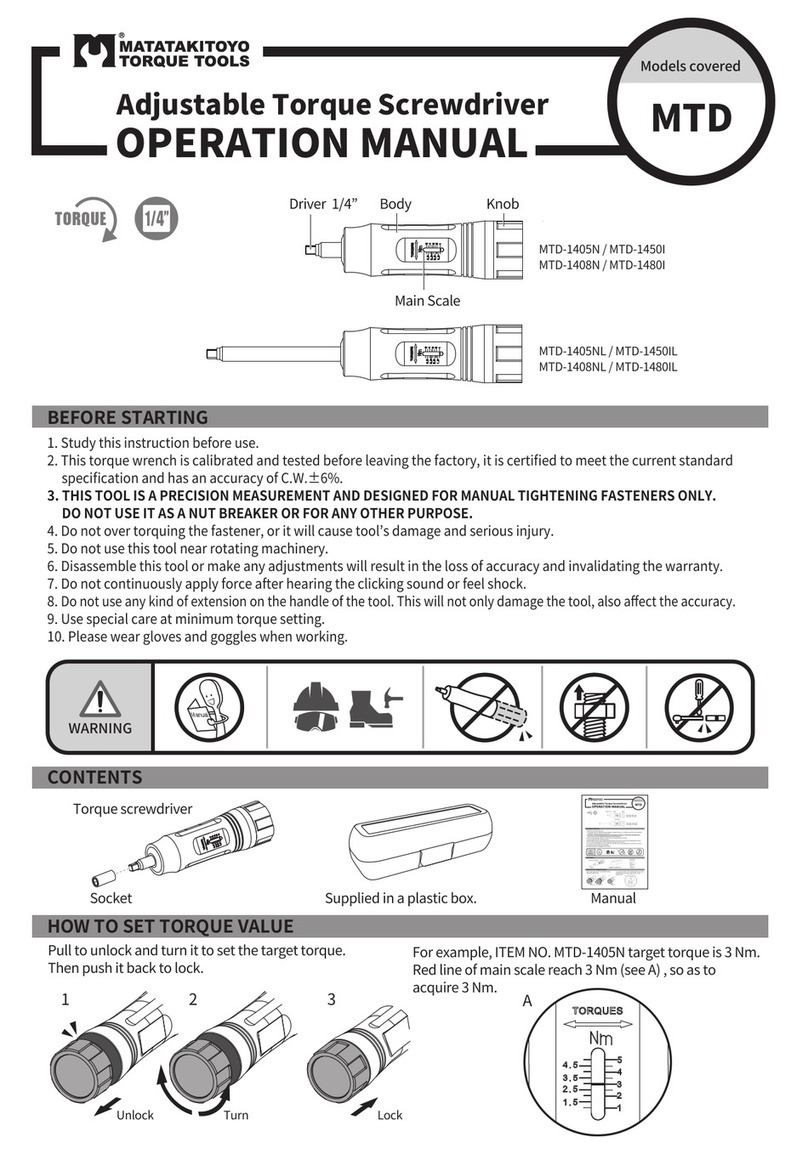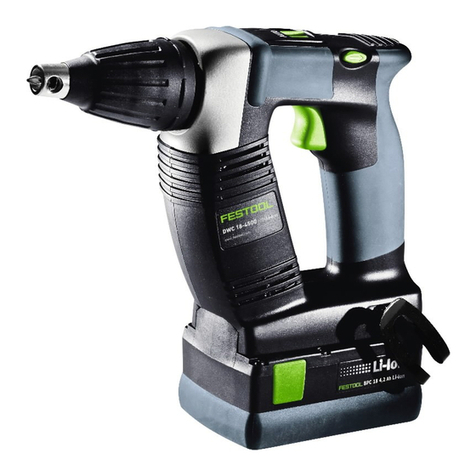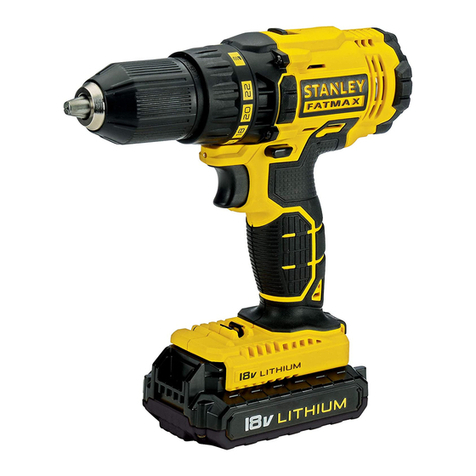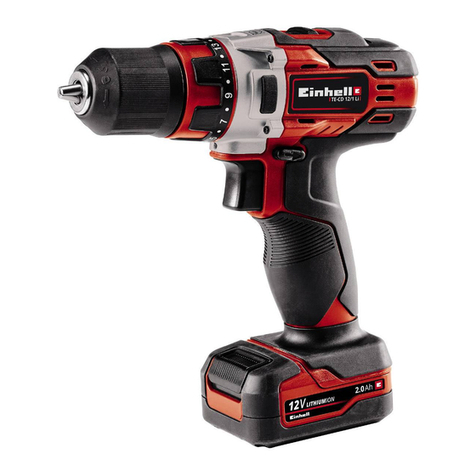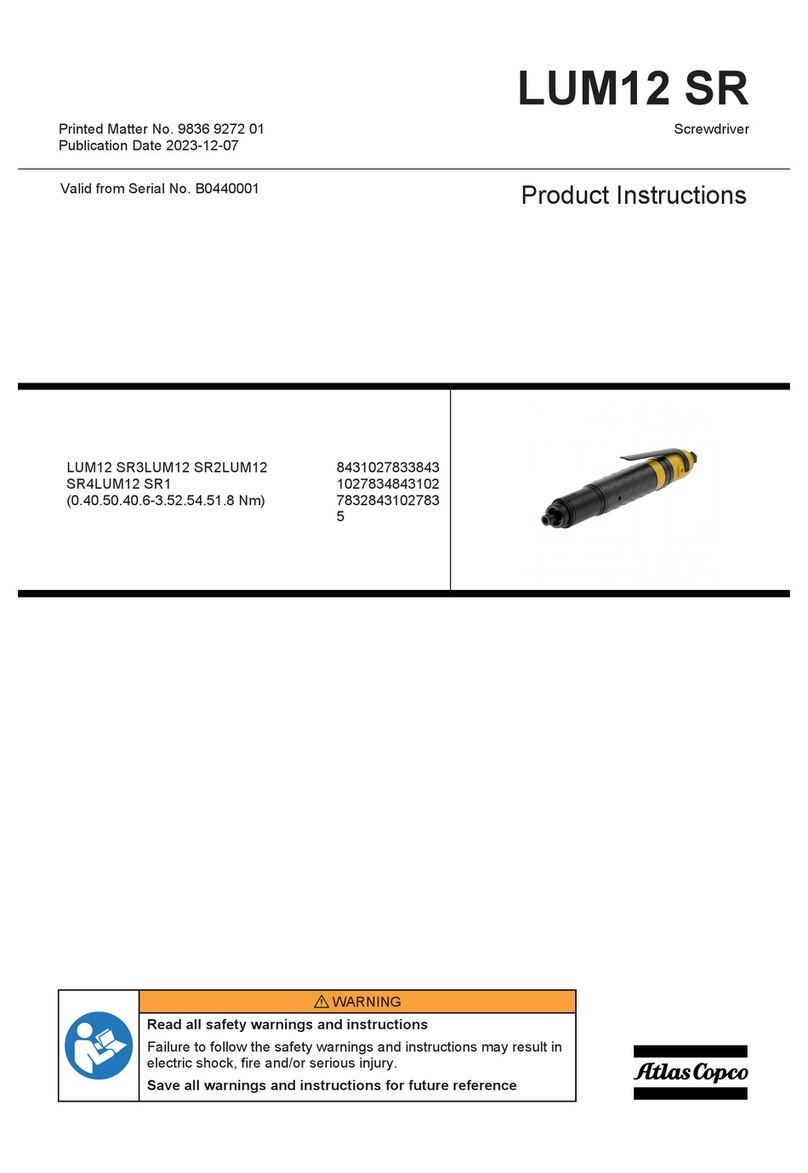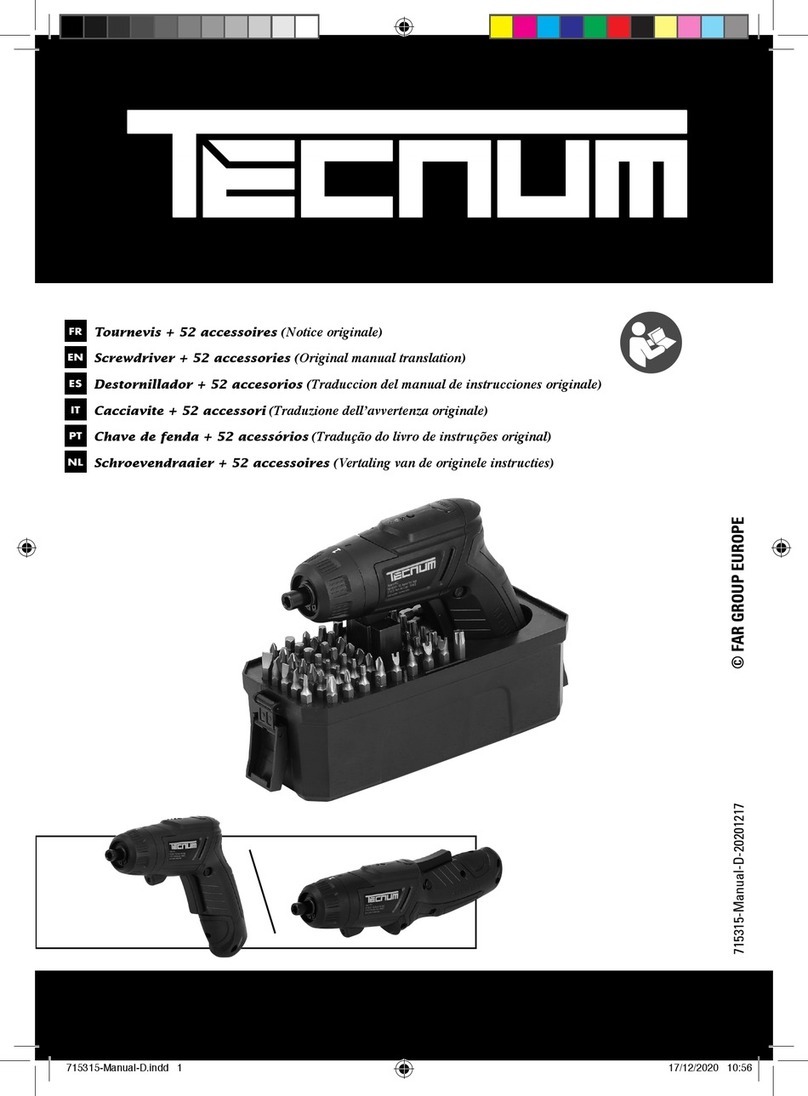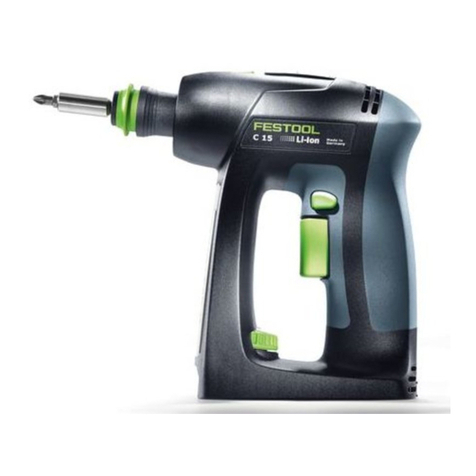
8ENGLISH
LED indicator / Beeper
Fig.6: 1. L ED i n d i c a t o r
L ED i n d i c a t o r / B e e p e r o n t h e t o o l s h o w s t h e f o l l o w i n g f u n c t i o n s .
Function Status of the tool Status of the LED indicator/beeper Action to be taken
LED indicator Beeper
C h e c k o f t h e L ED i n d i -
c a t o r , l a m p a n d b e e p e r
operation
W h e n t h e b a t t e r y c a r -
t r i d g e i s i n s t a l l e d , t h e t o o l
c h e c k s f o r i t s L ED i n d i c a -
t o r , l a m p a n d b e e p e r .
Lights up rst in green,
n e x t r e d .
( A n d t h e n t h e l a m p
c o m e s o n .)
A s e r i e s o f v e r y s h o r t
beeps
–
De t e c t i o n o f s w i t c h
t r i g g e r o p e r a t i o n w h e n
i n s t a l l i n g b a t t e r y
W h e n t h e b a t t e r y c a r t r i d g e
i s i n s t a l l e d w i t h t h e s w i t c h
t r i g g e r p u l l e d , t h e t o o l s t o p s
t o a v o i d u n i n t e n t i o n a l s t a r t .
B l i n k s i n r e d a n d g r e e n
a l t e r n a t i v e l y .
A s e r i e s o f s h o r t b e e p s R e l e a s e t h e s w i t c h
t r i g g e r .
A u t o -s t o p w i t h f a s t e n i n g
c o m p l e t i o n
T h e t o o l s e t t i n g h a s
b e e n a c h i e v e d a n d t h e
toolhas stopped.
L i g h t s u p i n g r e e n f o r
a p p r o x i m a t e l y o n e
second.
– –
Alarm against insu-
c i e n t f a s t e n i n g
T h e t o o l h a s n o t c o m p l e t e d
t h e t o o l s e t t i n g b e c a u s e t h e
s w i t c h t r i g g e r h a s r e l e a s e d
b e f o r e r e a c h i n g t h e s e t v a l -
u e s . O t h e r w i s e , t h e s e t t i n g s
o f " F a i l u r e C r i t e r i a f o r P h a s e "
has been achieved.
L i g h t s u p i n r e d . A l o n g b e e p R e t i g h t e n t h e s c r e w .
In t e r m i s s i o n b e t w e e n
t h e p h a s e s
T h e t o o l i s i n t h e i n t e r -
mitting period congured
b y t h e s e t t i n g o f " S h i f t t o
t h e n e x t P h a s e " .
L i g h t s u p o r b l i n k s i n
green (depending on
s e t t i n g s )
– –
Do u b l e -h i t t i n g d e t e c t i o n
W h e n t h e o p e r a t o r s t a r t s
t o r e -f a s t e n a n a l r e a d y -f a s -
t e n e d s c r e w , t h e t o o l d e t e c t
i t a n d s t o p s .
L i g h t s u p i n r e d . A l o n g b e e p –
A l a r m f o r l o w b a t t e r y
c a p a c i t y
T h e b a t t e r y p o w e r b e c a m e
l o w a n d i t i s t i m e t o r e p l a c e
t h e b a t t e r y c a r t r i d g e .
B l i n k s i n r e d s l o w l y . A s e r i e s o f l o n g b e e p s R e p l a c e t h e b a t t e r y w i t h
f u l l y c h a r g e d o n e .
A u t o -s t o p w i t h l o w
r e m a i n i n g b a t t e r y
c a p a c i t y
T h e b a t t e r y p o w e r i s
a l m o s t u s e d u p a n d t h e
toolstopped.
L i g h t s u p i n r e d . A l o n g b e e p R e p l a c e t h e b a t t e r y w i t h
f u l l y c h a r g e d o n e .
A n t i -r e s e t o f c o n t r o l l e r
T h e b a t t e r y v o l t a g e d r o p p e d
a b n o r m a l l y f o r s o m e r e a s o n ,
a n d t h e t o o l s t o p p e d .
B l i n k s i n r e d a n d g r e e n
a l t e r n a t i v e l y .
A s e r i e s o f s h o r t b e e p s R e p l a c e t h e b a t t e r y w i t h
f u l l y c h a r g e d o n e .
O v e r l o a d p r o t e c t i o n A n a b n o r m a l l y h i g h
current continued to ow
t h r o u g h t h e c o n t r o l l e r
a n d t h e t o o l s t o p p e d .
B l i n k s i n r e d a n d g r e e n
a l t e r n a t i v e l y .
A s e r i e s o f s h o r t b e e p s
R e m o v e t h e c a u s e o f
o v e r l o a d a n d r e s t a r t t h e
t o o l . If n o i m p r o v e m e n t i s
f o u n d , a s k y o u r l o c a l M a k i t a
S e r v i c e C e n t e r f o r r e p a i r .
O v e r h e a t p r o t e c t i o n T h e m o t o r o r t h e c o n t r o l -
l e r h e a t e d u p a b n o r m a l l y
a n d t h e t o o l s t o p p e d .
B l i n k s i n r e d q u i c k l y . A s e r i e s o f s h o r t b e e p s R e m o v e t h e b a t t e r y c a r -
t r i d g e i m m e d i a t e l y a n d
c o o l t h e t o o l d o w n .
F a i l u r e t o d e t e c t h e a t
o f m o t o r
T h e d e t e c t i o n u n i t o f
t h e m o t o r f a i l s t o d e t e c t
t h e h e a t b e c a u s e t h e
c o r d h a s b r o k e n o r o t h e r
r e a s o n s .
B l i n k s i n r e d q u i c k l y . A s e r i e s o f s h o r t b e e p s
R e m o v e t h e b a t t e r y c a r t r i d g e
a n d c o o l t h e t o o l d o w n . If t h e
i n d i c a t o r d o e s n o t s t o p , a s k
y o u r l o c a l M a k i t a S e r v i c e
C e n t e r f o r r e p a i r .
M o t o r o r c o n t r o l l e r f a i l u r e
d e t e c t i o n
M o t o r o r c o n t r o l l e r f a i l u r e
h a s b e e n d e t e c t e d . A t t h i s
t i m e , t o o l d o e s n o t w o r k .
B l i n k s i n r e d a n d g r e e n
a l t e r n a t i v e l y .
A s e r i e s o f s h o r t b e e p s A s k y o u r l o c a l M a k i t a
S e r v i c e C e n t e r f o r r e p a i r .
M a i n t e n a n c e a l a r m
A m a i n t e n a n c e t i m e h a s
c o m e a c c o r d i n g t o y o u r p r e -
s e t n u m b e r o f s c r e w s d r i v e n .
B l i n k s i n y e l l o w . –R e s e t t h e a l a r m w i t h t h e
a p p l i c a t i o n s o f t w a r e .
A l a r m f o r u n a v a i l a b l e d a t a
c o m m u n i c a t i o n ( w i t h t h e
t o o l i n c o n n e c t i o n w i t h P C )
Da t a c a n n o t b e e x c h a n g e d
b e t w e e n t h e t o o l a n d P C i n
s p i t e o f t h e c o n n e c t i o n .
B l i n k s i n y e l l o w . –R e s t a r t t h e a p p l i c a t i o n
s o f t w a r e a n d r e -c o n n e c t
t h e U S B c a b l e .
In d i c a t i o n t h a t d a t a c o m -
m u n i c a t i o n i s a v a i l a b l e
( w i t h t h e t o o l i n c o n n e c -
t i o n w i t h P C )
T h e t o o l i s c o n n e c t e d t o
P C a n d d a t a c o m m u n i -
c a t i o n i s a v a i l a b l e .
B l i n k s i n g r e e n . – –
